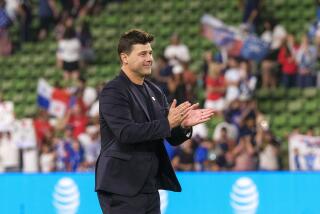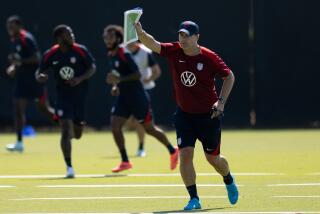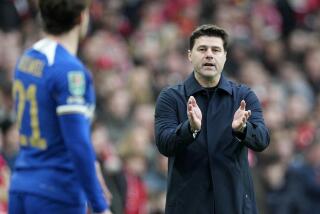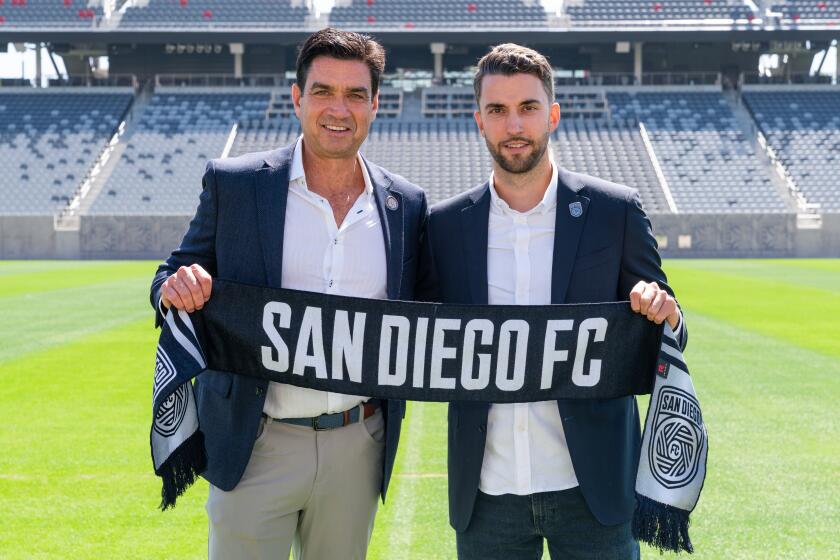HAVE NO FEAR
The surgeon general, having never been asked to concoct a viable defensive strategy to shut down Germany, has yet to make an official ruling, but American soccer coaches know the blunt truth: The World Cup can be hazardous to your health.
Professionally speaking, no U.S. national soccer coach has survived one yet.
Bob Gansler in 1990 became the first U.S. coach in 40 years to qualify for the World Cup, then went 0-3 in Italy and was out by early 1991.
Bora Milutinovic took the United States further than anyone had reason to expect in 1994--to the second round and a 1-0 loss to eventual champion Brazil--and then, once the confetti was swept up, Bora was handed his walking papers in March of â95.
Steve Sampson, now astride the ejector seat, knows his history. He knows the odds of him conducting pre-World Cup workouts in June of 2002 are not good. He knows his chances of advancing to the second round in 1998--which means finishing ahead of either Germany or Yugoslavia in group play--are no less slim.
Yet, as he approaches the gauntlet of France â98, Sampson does not toss and turn in his sleep, tormented by nightmares of Alan Rothenberg, president of U.S. Soccer, chasing him around with a bloody hatchet.
No more, anyway.
Sampson got that out of his system long ago.
In 1995, after being named interim coach after Milutinovicâs dismissal, Sampson had to win the job while Rothenberg conducted a very public anybody-but-Sampson worldwide search for a permanent coach--winning it only after Carlos Parreira of Brazil and Carlos Queiroz of Portugal turned it down.
In 1997, Sampson had to qualify for the World Cup with one eye perpetually cast over his shoulder as Rothenberg dropped loud hints after every tie with Jamaica or El Salvador that even if the United States qualified for France, Sampson was not guaranteed a seat on the team plane.
Even now, as Sampson pours over videotapes of Jurgen Klinsmann and Thomas Hassler, Queiroz hovers in the background like a specter--a veritable coach-in-waiting serving a seven-month term as âspecial consultantâ to U.S. Soccer, a contract that expires in August, four weeks after the World Cup final.
Having fought the uphill battle for so long, Sampson has accepted the fact that his tenure could end any time after June 25--the United Statesâ final game in World Cup group play.
If not thrilled by the circumstances, he seems to at least have made his peace with them.
âI know that if they fire me today,â Sampson says, âI will be very proud of my accomplishments.
âI have the best record of any coach with the U.S. national team. We did qualify for the World Cup--and although it was a struggle, at times we played very well. We scored some historic victories along the way--beating Mexico, 4-0 [in 1995], beating Argentina [in the 1995 Copa America], beating Brazil [in the 1998 Gold Cup].
âI have managed to embrace the entire Hispanic community, which no other American coach has done. I managed to win them over, to make the U.S. national team their team--El Equipo para Todos. Everyoneâs Team.
âI also feel very proud of the fact weâve been able to integrate all the national-team programs with one core philosophy. We now have communication from one level to the next, which was never in existence before.
âLastly, Iâm very proud of the style of play we have adopted. I think my legacy will show that the U.S. national team transformed itself during the last few years. Instead of playing not to lose, we now play to win. No one will ever be able to take that away from me.â
Sampson, 41, has also transformed himself during his three years as U.S. coach. At first, he was the Great Emancipator, opening up the offense and unshackling the players from the ties that tethered them so tightly during the Bora dictatorship, and the Great Communicator, able to address American players in plain English sentences instead of infamous indecipherable mysticisms of Bora-speak.
For those reasons, Sampson began his tenure as the consummate playersâ coach, beloved by his squad, which responded in 1995 with two of the most memorable results in the history of U.S. soccer--the 4-0 thrashing of Mexico in Washington and a 3-0 victory over Argentina en route to the semifinals of the Copa America.
But the difficult World Cup qualification process of 1996-97 took its toll on Sampson and his players, tugging and pulling their relationship into new and often uncomfortable directions. Sampson sparred with two of the biggest names and egos in American soccer, all-time leading scorer Eric Wynalda and captain John Harkes, causing the ever-popular playersâ coach to make some unpopular decisions.
Wanting to see more defensive attentiveness out of the hellbent-for-goal Wynalda, Sampson moved Wynalda to midfield for a spell--which Wynalda hated--then benched him. But as the U.S. attack began to cough and sputter, Sampson and Wynalda struck a compromise agreement that helped lead to the birth of Sampsonâs 3-6-1 âWorld Cup specialâ formation.
Because Sampson desperately needs Wynaldaâs goal-scoring ability, he installed Wynalda as the lone striker atop the 3-6-1. And because he still wants more defense in the attacking half of the field, Sampson loaded the midfield with six supporting players behind Wynalda.
No such accord was struck with Harkes, who refused to accept a more defensive role, either at fullback or at holding midfielder, and challenged Sampson over such strategy in front of the team on the practice field.
Harkes also irked Sampson by partying into the early morning hours two days before a Feb. 25 match against Belgium in Brussels, missing two team flights and frequently arriving late for team meetings.
So on April 16, in a bombshell announcement, Sampson not only stripped Harkes of his captaincy but cut him altogether--dumping a 10-year veteran of the U.S. national squad, a respected team leader, two months before the World Cup opener.
Harkes has called his dismissal âa travestyâ and demanded a public apology from Sampson, which, as longshots go, is about as likely as Team USA parading around the Champs-Elysees on July 12 hoisting the World Cup.
âMy decision was done alone, but it was not done haphazardly,â Sampson says. âIt was done in consultation with my entire staff, in consultation with key players of the national team.
âThatâs not to say the players were universally in favor of it. But if I had felt the decision would have been met with overwhelming disapproval, I still would have made the same decision. There are certain things a coach cannot accept.â
But to jettison the captain of your team, a veteran of the 1990 and 1994 World Cups, a savvy and experienced hand who wouldnât flinch at the first sight of a German crest on the pitch in Paris on June 15?
âIt was a bit of a risk,â Sampson concedes. âAnd part of the risk is attempting to embrace the veteran players, [to show them] that this is not an attack at them as much as it is trying to make this the very best team that will represent this country in the World Cup.
âI was very clear in January when I said I would pick the best team, not necessarily the best 22 players. . . . In a tournament like this, especially in the United States, where we donât have two or three players that can carry a team individually, we have to be able to play as a unit and work very hard for each other in order for us to have success.
âThere can be no question in anybodyâs mind that someone is going to work for me when I need them to.â
So, instead of Harkes in the vital position of holding midfielder, Sampson will deploy Chad Deering and Brian Maissoneuve, two relative newcomers to the U.S. team with fewer than 20 international appearances combined.
That is not the advised method of sending an already undermanned team into the caldron of World Cup competition, but Sigi Schmid, coach of the U.S. under-20 team, says he can understand Sampsonâs rationale.
âMaissoneuve and Deering are so happy to be on the team, theyâll do anything for him,â Schmid says, âYou tell them, âPlay in the back, seal off and do the dirty work,â and theyâll say, âThank you very much.â
âWhen youâre 31 and youâre told to do the dirty work for guys 24 years old playing in front of you, youâre going to get a different reaction. What Steve has done is put players on the field who are hungry.â
Still, Sampson is very much a pragmatist. Asked why his spats with Wynalda and Harkes came to entirely different resolutions, Sampson quickly retorted, âThereâs one clear difference: One puts the ball in the back of the net. One doesnât.â
Wynalda views his relationship with Sampson in similar terms, to a point.
âWe are kind of different people, Iâm the first to admit that,â Wynalda says. âI still think the pluses outweigh the minuses, as far as what I can bring to the team. I feel the same way about John Harkes.â
Yet, as someone who played for Milutinovic and Sampson, Wynalda says he can appreciate what Sampson has brought to U.S. soccer and the national team.
âBora, heâs someone I think weâve always misunderstood,â Wynalda says. âEverybody misunderstood him. He did great things for this team and for some of us personally. . . .
âBoraâs troubles with the language gave him some problems. Some people misunderstood him, found it hard to believe in him, some guys were struggling with that. And that lack of belief probably hurt us a little bit.
âSteve Sampson is someone who brings out the best in players. Heâs not afraid to tell you he believes in you and heâs not afraid to go out on a limb for you. If that aspect was lacking in Bora, I think itâs just because he didnât understand the American mentality. He had a hard time communicating with us.
âSteveâs a great coach--heâs able to communicate with us. And thatâs one of the reasons why weâre more successful with Steve.â
One other difference between Bora and Sampson: When confronted with mission improbable, Bora will bring on an extra defender and circle the wagons around his goal, whereas Sampson will roll the dice, gambling on new formations and new captains and new defenders just naturalized from France.
âThroughout the process when I was interim coach,â Sampson says, âit was obvious they were looking for someone besides Steve Sampson.
âSo I told myself, âIf I only have a few months, I want to show them what Steve Sampson is all about.â And that is very much an offensive approach to soccer. I also firmly believe that in order for the game to grow in the United States, you have to play exciting soccer and as a coach, you have to take risks.â
It worked once, in 1995, when Sampson had a job to win. Tried and tested coaching wisdom holds that you stick with something that works, especially when itâs your job to lose.
(BEGIN TEXT OF INFOBOX / INFOGRAPHIC)
STEVE SAMPSON AT A GLANCE
* Age: 41.
* Hometown: Agoura Hills.
* Family: Wife Sheri and children Brandon, Emily and Trevor.
* Playing background: Was a junior college All-American at Foothill College in Los Altos in 1976. Also played at UCLA and San Jose State.
* Coaching background: Assistant coach at UCLA, 1982-85. Head coach at Santa Clara, 1986-90, compiling an overall record of 64-19-19 and winning the 1989 NCAA Division I co-championship. Assistant coach for the U.S. national team, 1993-95. Named interim coach of U.S. national team April 14, 1995. Appointed head coach of U.S. national team Aug. 2, 1995.
* Record as U.S. national coach: 25-19-14.







